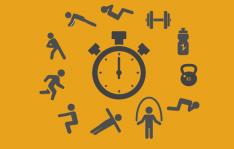Swimming
There's a reason even fit women end up hanging onto the side of the pool when they first start doing laps. "In swimming, you use every single one of your muscles to stay afloat and work through the tension of the water," says Pete McCall, exercise physiologist with the American Council on Exercise. "And since those muscles need oxygen and fuel, your body is asked to work harder."
But have no fear! Once you get your feet (and the rest of you) wet, you'll build endurance fast and quickly learn to love this soothing, no-impact workout that burns more than 500 calories an hour.
More: Everything You Need to Know Before Your First Triathlon Swim
Technique 101
Breathe. "It's the single most important thing to master in swimming," says Shepley. A steady inhale/exhale rhythm keeps you relaxed (like in yoga) while increasing your speed and eliminating the need to gasp for air every couple of strokes. Breathe out of your nose while your face is in the water and, on every other stroke, tilt your head to the side, halfway out of the water, and take in oxygen.
Once you're comfortable with that, breathe in on every third stroke to practice getting air on both sides--a handy skill in open water since waves may break on your favored side.
More: Proper Breathing for the Swim
Roll with it. Rotate your shoulders, torso, and hips with each stroke to help you glide through the water. "If you rotate your body from side to side--rather than swimming flat--you'll move like a torpedo," says Shepley. In other words, fast as hell.
Kick sparingly. Save your legs for the bike and run, and rely mostly on your arms to pull you through the water. This prevents lactic acid from building up in your legs, which in turn keeps your legs from tiring so they're ready when you really need them. During training, squeeze a pool buoy between your legs as you swim to practice using your upper body.
More: 5 Steps to Master the Freestyle Kick for a Triathlon Swim
Do It!
At first, aim to swim 250 meters once or twice a week. If you're sucking wind (or water), break it into intervals of 25 meters (usually one length of a pool) of nonstop swimming with 20 seconds of rest in between to catch your breath. During the final month, make one session each week an open-water swim, if possible, and practice sighting by looking up every six to eight strokes to confirm you're on course.
Start each workout with 10 to 15 minutes of the following warmup drills. These three exercises from Shepley will refine your stroke and help you generate more power so you can learn to glide through the water effortlessly.
Catch-up drill (for stroke timing): Swim freestyle as usual, but leave one hand in front until your other hand finishes the stroke and comes around to "tag" it.
Side-swim drill (for body position): Hold your left hand in front of you, palm down. Swim with your left side, eyes looking at the bottom of the pool and right hand glued to your right thigh for six kicks. Stroke with your left hand, rotate, and switch sides. Repeat.
Fingertip drag (for arm position): As each hand ends its stroke, keep your elbow high and carefully drag your fingertips along the surface as you bring your arm forward.
- 2
- of
- 5








Discuss This Article